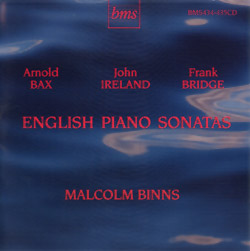Malcolm Binns English Piano Sonatas- Review by Christopher Webber
 ARNOLD BAX – English Piano Sonatas, Malcolm Binns
ARNOLD BAX – English Piano Sonatas, Malcolm Binns
Review by Christopher Webber
THE SIR ARNOLD BAX WEB SITE
Last Modified January 12, 2007
English Piano Sonatas
Malcolm Binns (piano)
Bax: Piano Sonatas Nos.1-4 (plus two appendices taken from the manuscript draft of Sonata No.2); Ireland: Piano Sonata; Bridge: Piano Sonata
BMS 434-435CD [TT=146:58]
[ rec. Menuhin Hall, Yehudi Menuhin School, 16 and 30 May, 13 June, 18 July 2007. Producer: John Talbot. Recording Engineer: Paul Arden-Taylor]
review by CHRISTOPHER WEBBER
My first response to Malcolm Binns’s playing is wonderment. Such rock-solid technique is remarkable for a man surpassing three scores years and ten, power and touch alike undimmed by time. His performances of these demanding English sonatas demonstrate the qualities for which Binns has been renowned for half a century: balance, poise, and a subtle intelligence completely at the service of the music. No wonder this doyen of British musicians has been so often called “the pianist’s pianist”.
That label, though, carries a warning on the packet; and despite the impeccable playing I soon found myself longing for something less cautiously controlled. Order is maintained at the cost of spontaneity. I waited in vain for the spark from heaven to fall. Yet if there’s little exceptional here, neither is there much at which to take exception. Ireland’s assured essay in introspection comes off beautifully in a well-shaped reading, albeit one which scrupulously avoids emphasising what contrasts there are on offer. Contrast is not the issue in Bridge’s dourly monochrome piece, a tricky thing to pull off at the best of times. Without sustained intensity it is a dull dog, and like others before him Binns only manages to make it seem morose. Lewis Foreman suggests in a somewhat rambling but absorbing discussion with the pianist that “in terms of absolute stature [the Bridge] is the greatest of all these pieces”. I echo Binns’s gentlemanly dissent.
No. Coming to what many readers of this review will consider the main meat, the Bax Four receive assured treatment almost throughout from a man who has known and loved them all for decades. The qualification is the final movement of the 3rd Sonata, where his eye seems fixed on the technical rather than artistic goal. Things cohere but only just, and the coda’s return to the sonata’s opening – the Celtic doom-snake swallowing its own tail – brings relief rather than fulfilment. Binns makes it clear in that printed discussion that this is his favourite of the four. He acknowledges its elusive difficulties, and in his account of the first two movements overcomes them most satisfyingly. In the slow movement he restores some ornamental sextuplets at the point Bax modulates into E flat which were cut out before the work was printed: no great matter in itself, but typical of the scrupulous care with which Binns has approached the texts. He has made use of the British Library manuscripts as well as all available printed sources, one of them – the later of two 1921 Murdoch editions of the 2nd Sonata – not even listed in Graham Parlett’s superlative OUP Catalogue o f the composer’s work. Now that is dedication!
f the composer’s work. Now that is dedication!
That 2nd Sonata’s turbulence is fractionally under-projected. A comparison with the recording Binns made over a quarter of a century ago for Pearl (not transferred to CD) reveals little difference in general approach, but the earlier, slightly more expansive reading has at crucial points an ounce of virile excitement which makes for the difference between a good performance and something which is simply correct. Yet if the hay-day in the blood grows tame, there are compelling textural reasons for adding this new version to the Baxian library, all tabulated in clear detail by producer John Talbot in another valuable liner note. Most apparent is the addition of a short passage played twice, between bars 49 and 50, and bars 343 and 244 (the first time marked dizzily) which only appears in the MS. The implication is that this passage was cut because Harriet couldn’t play it, but is it not just as likely that Bax cut it by choice, because he felt it delayed the musical climax?
There are further, minor changes where Binns adopts tempo markings or restores notes found only in the MS, none of them making much audible effect unless you’re following with a score. It was an imaginative thought to give us two appendices, featuring the first and last MS appearances of a flimsy 12/8 dance-like theme which was scrapped in favour of the inspired Lento, very still and concentrated which lies at the heart of the finished work. Well worth hearing – as proof positive that Bax didn’t just slap down the first thing that came into his head and leave it at that. The reworking is an example of the old saw that genius is merely an infinite capacity for taking pains.
As for the 1st and 4th Sonatas, the same pros and cons hold. Binns is strong on sensitivity, but damps down dramatic contrast and character. The pawky humour of the distorted Maiden with the Daffodil theme at the start of the 4th Sonata, for example, is fined down to a sunny shade; whilst the muted tintinnabulations of the 1st’s coda make for a polite triumph. In sum, the abiding interest of this Bax cycle is likely to lie in its minor textual deviations from the norm. Pleasure in the sensitivity and good manners of Malcolm Binns’s affectionate readings is tempered by disappointment at their lack of fire.
One baldly impertinent query: what motivated the British Music Society to pursue this project? All these sonatas have had multiple recordings, many of them decent and several outstanding. In particular, what was the point of adding another Bax cycle to the six already in existence, two of them completed within the last couple of years? Binns does not include the Symphony-Sonata, so powerfully done by Michael Endres in his outstanding integrale for OEHMS Classics; and the seven minutes’ worth of MS appendices, intriguing though they are, hardly justify the venture. The recording has exemplary warmth and clarity, the documentation has been assembled with care and expertise; but would not the Society do better to spend its precious resources on new work, or under-exposed piano pieces from our 20th century heritage? Bax, Ireland and Bridge have had some globally-marketed CD chances in this repertoire, and they’ve made the most of them. There has to be a suspicion that the BMS is more interested in comfortable nostalgia than in fighting British music’s corner on the rough, tough contemporary cultural battlefield.
© Christopher Webber 2008
